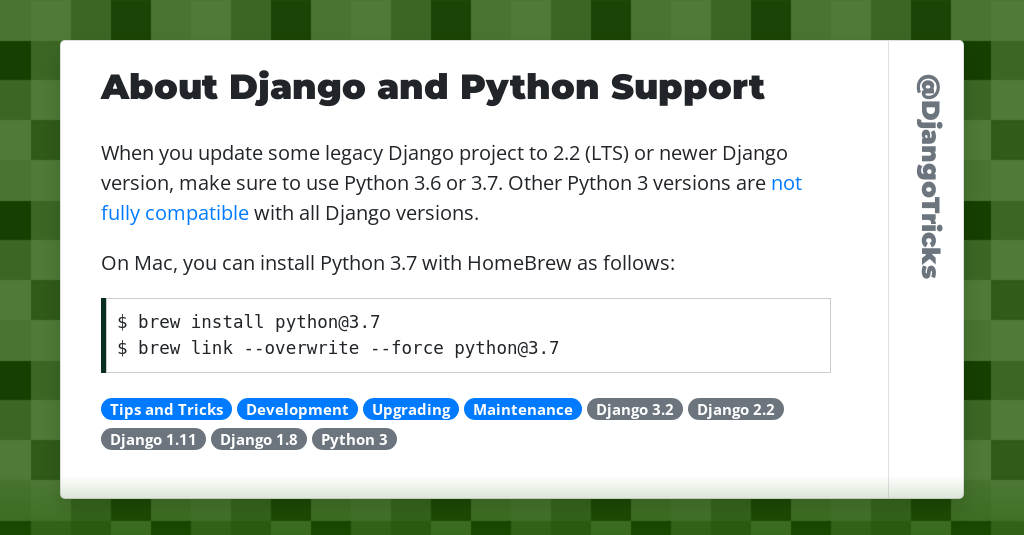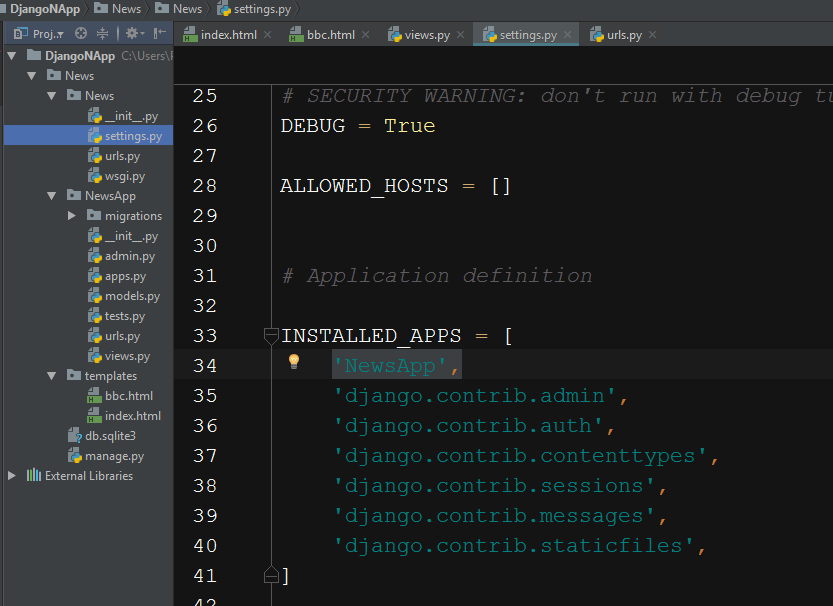

- #DJANGO PYTHON FOR MAC HOW TO#
- #DJANGO PYTHON FOR MAC MAC OS X#
- #DJANGO PYTHON FOR MAC INSTALL#
- #DJANGO PYTHON FOR MAC UPGRADE#
#DJANGO PYTHON FOR MAC INSTALL#
First, you download the virtualenv source code, unpack it and install it using your global Python interpreter.
#DJANGO PYTHON FOR MAC MAC OS X#
Installing virtualenv and Django on Mac OS X and Linux is similar to Windows. Setup virtualenv and Django in Mac OS X and Linux Now you can install Django inside the new virtual environment. Notice that once the virtualenv is activated, you will see a string "(python2-workspace)" prepended to your command line's shell prompt. Therefore, we need to change the execution policy to AllSigned in order to be able to activate the virtualenv. Note that Windows' execution policy is restricted by default which means scripts such as activate cannot be executed. Now we can activate the new environment using the activate script. > python.exe -m virtualenv python2-workspace Now you can create a virtualenv instance in your home directory. Note: without Setuptools installed you will have to use "python -m virtualenv ENV" Then you can change into that directory to install virtualenv for your current Python interpreter which could be invoked from command line. Second, open a Powershell instance and navigate to the directory into which you have downloaded the virtualenv source code and extract the tar file into a directory. Click the download button to get the source code of the latest virtualenv. Setup virtualenv and Django in Windowsįirst, open your browser and navigate to virtualenv. Luckily, virtualenv solves all the aforementioned issues by creating an environment that has its own installation directories who do not share any library with other environments. Wouldn't it be nice if you can create a Python environment inside your home directory? Or imagine that you are programming on a shared hosting environment where your user does not have access to root-level directories such as /usr/lib which means you cannot modify the global Python environment into a version that you like. Wouldn't it be nice if you can write my_library against an independent 1.0.0 dependent_library as well as another upgraded_my_library against 1.2.0? Now my_library won't work anymore since it's calling methods and using classes from the 1.0.0 of dependent_library.

#DJANGO PYTHON FOR MAC UPGRADE#
When you upgrade the global Python environment from 2.7.3 to 2.3.3, dependent_library also gets upgraded to 1.2.0. Well, let's imagine a situation where my_library depends on another package dependent_library whose version has to be 1.0.0. Why do we need virtualenv since we can just write code running on top of the global Python environment? Instead of writing code on top of one global Python environment, virtualenv allows you to create isolated "islands" or directories of Python environments each of which is an independent Python environment that has its own "system-level" packages and libraries. virtualenv is a tool to create isolated Python environments.

Assuming you have Python 2.7.x installed on your OS, we will walk you through the steps to create a Django development environment on Window, Mac OS X and Linux in the following sections.īefore we dive into the steps to create a Django development environment, we'd like to review a useful tool called virtualenv. However if it is not, you can download and install the appropriate Python version for your OS on the official Python website. Often Python is already installed on your system if you're using a mainstream OS such as Windows, Mac OS X or Linux.
#DJANGO PYTHON FOR MAC HOW TO#
Windows, however, is so different from the other two operating systems that we need use one section to present the instructions about how to install Django on Windows. Since Mac and Linux are both derived from the Unix platform, the instructions about installing Django on Mac and Linux are almost identical to each other and we will present them in the same section. In this article, we are going to learn how to install Django on Windows, Mac and Linux. Last Updated: Wednesday 29 th December 2021


 0 kommentar(er)
0 kommentar(er)
